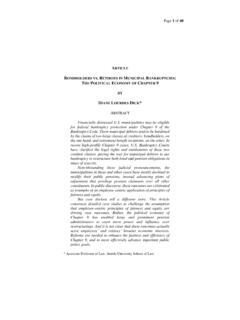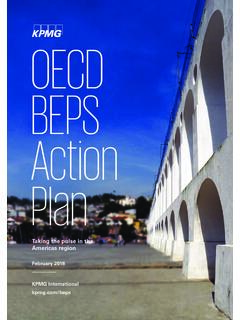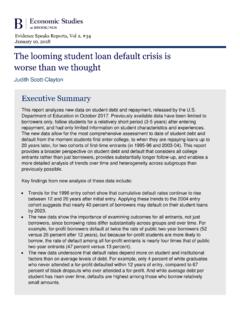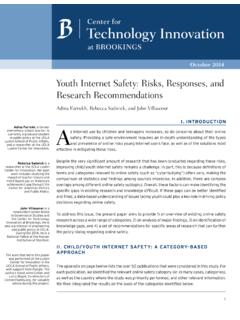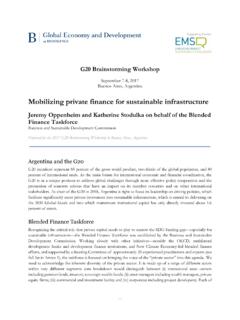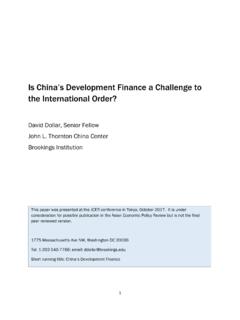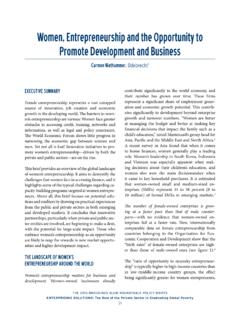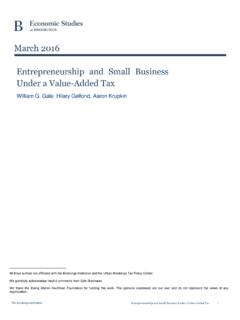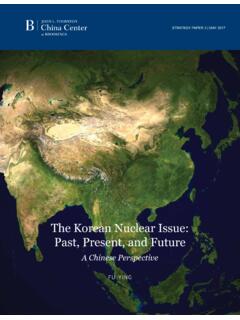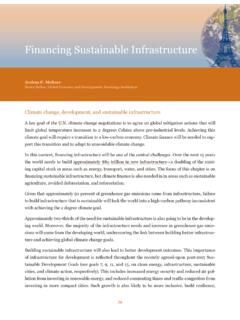Transcription of Industrial policy and development in Ethiopia: Evolution ...
1 Industrial policy and development in Ethiopia: Evolution and present experimentation Mulu Gebreeyesus* Abstract There has recently been a resurgence of interest in Industrial policy . This paper examines the choices, implementation processes, and outcomes of the Ethiopian present Industrial policy . The country represents an excellent case study of recent Industrial policy experimentation in Africa as it is one of the few countries that has formulated and implemented a comprehensive Industrial policy early on when the term Industrial policy had been a taboo in the international policy forums.
2 By providing detailed assessment of the policy practice this paper seeks to inform the ongoing Industrial policy debate. Keywords: Industrial policy , manufacturing, Ethiopia, Africa JEL classification: L6, L52 Working Paper No. 6 *UNU-MERIT, email: Brookings Institution is a private non-profit organization. Its mission is to conduct high-quality, independent research and, based on that research, to provide innovative, practical recommendations for policymakers and the public. Brookings recognizes that the value it provides is in its absolute commitment to quality, independence and impact.
3 Activities supported by its donors reflect this commitment and the analysis and recommendations are not determined or influenced by any donation. Learning to Compete (L2C) is a collaborative research program of the Africa Growth Initiative at Brookings (AGI), the African development Bank, (AfDB), and the United Nations University World Institute for development Economics Research (UNU-WIDER) on Industrial development in Africa. Outputs in this Working Paper Series have been supported by all three institutions. AGI-Brookings is grateful for the contribution of an anonymous donor for funding its work under the collaborative research program.
4 The views expressed in this publication are those of the author(s), and do not reflect the views of the Institution, its management, or its other scholars. Publication does not imply endorsement by any of the collaborating institutions or their program sponsors of any of the views expressed. 2 1 Introduction The manufacturing sector has long been considered the main engine of economic growth and structural transformation (Prebisch 1950; Singer 1950). There are numerous arguments supporting this The road towards industrialization, however, has never been even. Several countries in Asia have successfully industrialized in the last few decades, while Africa faced de-industrialization (Page 2009).
5 Rodrik (2004) argues that the success in East and South Asian countries was not the result of conventional recommendations of liberal markets and the restricted role of the government but a mix of standard and non-standard policies. The lack of progress in Africa, on the other hand, casts doubt on the structural adjustment programmes (SAPs) that took place in the 1980s and 1990s with a main focus on liberalization and improvement of investment climate. Industrial policy is back on the development agenda. A number of countries in the developing world and particularly Africa have shown a renewed interest and started to reintroduce Industrial Governments from several rich countries have also advocated for state intervention in industry following the 2008 financial crisis (The Economist 2010).
6 Yet controversies remain; for example whether governments should favour specific sectors over others ( functional versus selective Industrial policy ), whether Industrial strategies should follow or defy comparative advantage (Lin and Chang 2009), and on the nature of state-business relationship ( Hausmann and Rodrik 2006). One of the longstanding critics against Industrial policy points at the inability of the state bureaucrats to pick winners and the high probability that they promote rent seekers instead (Pack and Saggi 2006). The recent advocates of Industrial policy ( Rodrik 2004; Hausmann and Rodrik 2003) have emphasized the need for strategic collaboration between the private sector and the state with the aim of uncovering where the most significant obstacles to restructuring lie and what type of interventions are more likely to remove them.
7 Yet, little systematic evidence exists on the institutional characteristics of public-private co-ordination outside of the well-known cases of East Asia (Page 2010).3 Thus, we know little about the quality and impact of particularly recent attempts to reintroduce Industrial policy in Africa. The aim of this study is to address the gap in this literature by analyzing the choices, implementation processes and outcomes of the Ethiopian present Industrial policy . Ethiopia represents an excellent case study of the recent Industrial policy experimentation in Africa. First, it is one of the few African countries that have formulated and implemented a full-fledged Industrial development Strategy (IDS) since the early 2000s when Industrial policy had been a taboo in the international policy forums.
8 Unlike to many other reform policies that had to be agreed on with the international financial institutions, the IDS was designed by the Ethiopian government and based on its broad development vision, known as Agricultural development Led Industrialization (ADLI). In defiant to the neo-liberal advice the strategy advocates for a strong state role to guide the private sector in the development process, which GRIPS (2010) termed it as pro-active Industrial policy . 1 Szirmai (2009) has an excellent review of the theoretical arguments and empirical observations on this. 2 In fact, African governments have also collectively taken initiatives to promote industrialization in Africa under the theme industrialization of Africa at their January 2008 summit.
9 3 Altenburg (2011) examines the Industrial policy practice in low-middle-income countries covering seven African and Asian countries including Egypt, Ethiopia, Mozambique, Namibia, Syria, Tunisia, and Vietnam. 3 Second, the Industrial policy -making process has been characterized by more flexibility and scope for policy learning. This has been reflected in a continuous updating of the priority sectors and policy instruments introduced to promote the selected sectors. Third, the government has shown extraordinary commitment and ownership.
10 It exerted maximum efforts implementing the IDS through subsequent development plans and various sub-sector strategies. By providing a detailed assessment of the Ethiopian present Industrial policy this study seeks to inform the ongoing Industrial policy debate. The remaining part is organized as follows. The next section gives some background on the Evolution of industry and Industrial policy in Ethiopia. Section 3 describes the structure of the Ethiopian manufacturing sectors. Section 4 examines in detail the present Industrial policy framework and practice. It also provides case studies of three industries on the implementation of the direct support for selected sectors.
